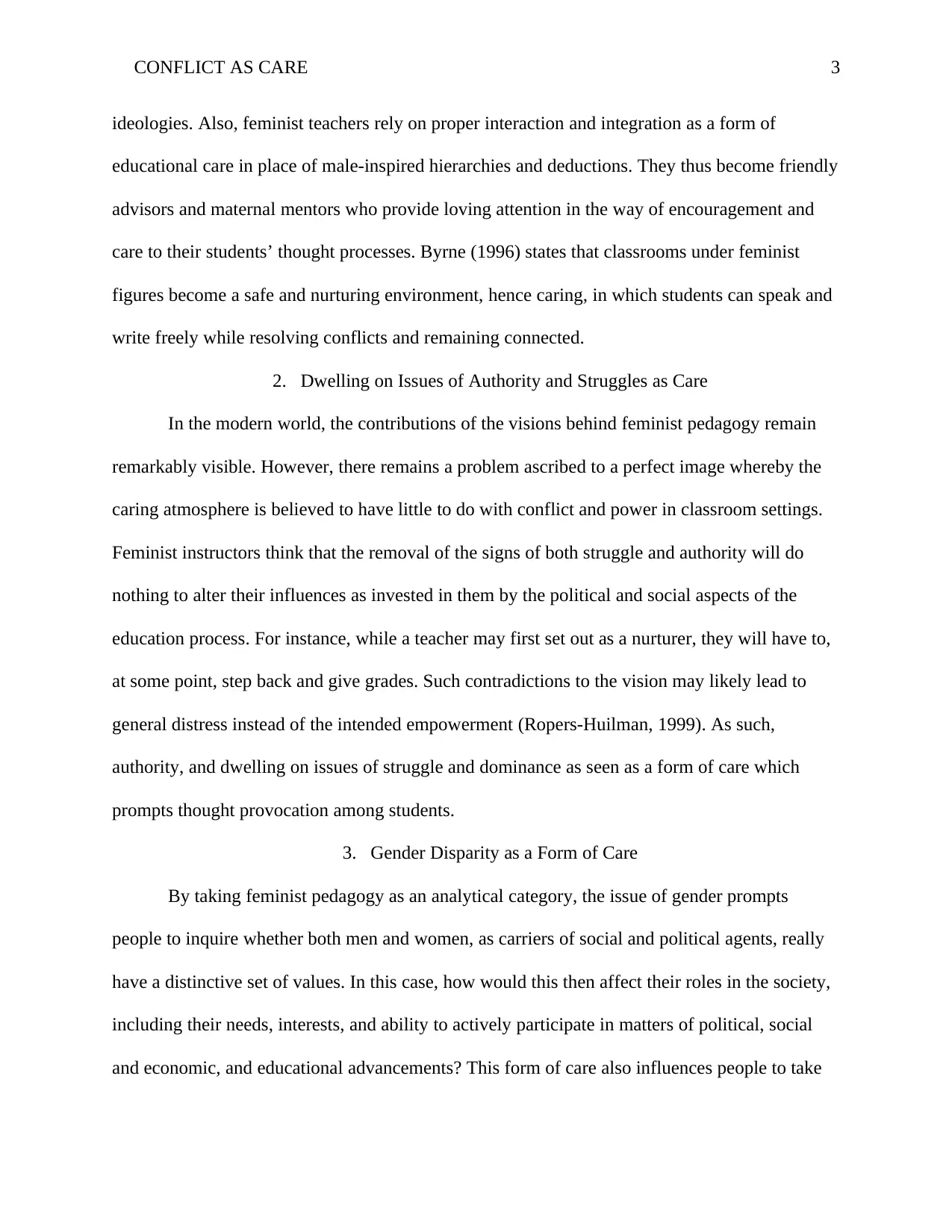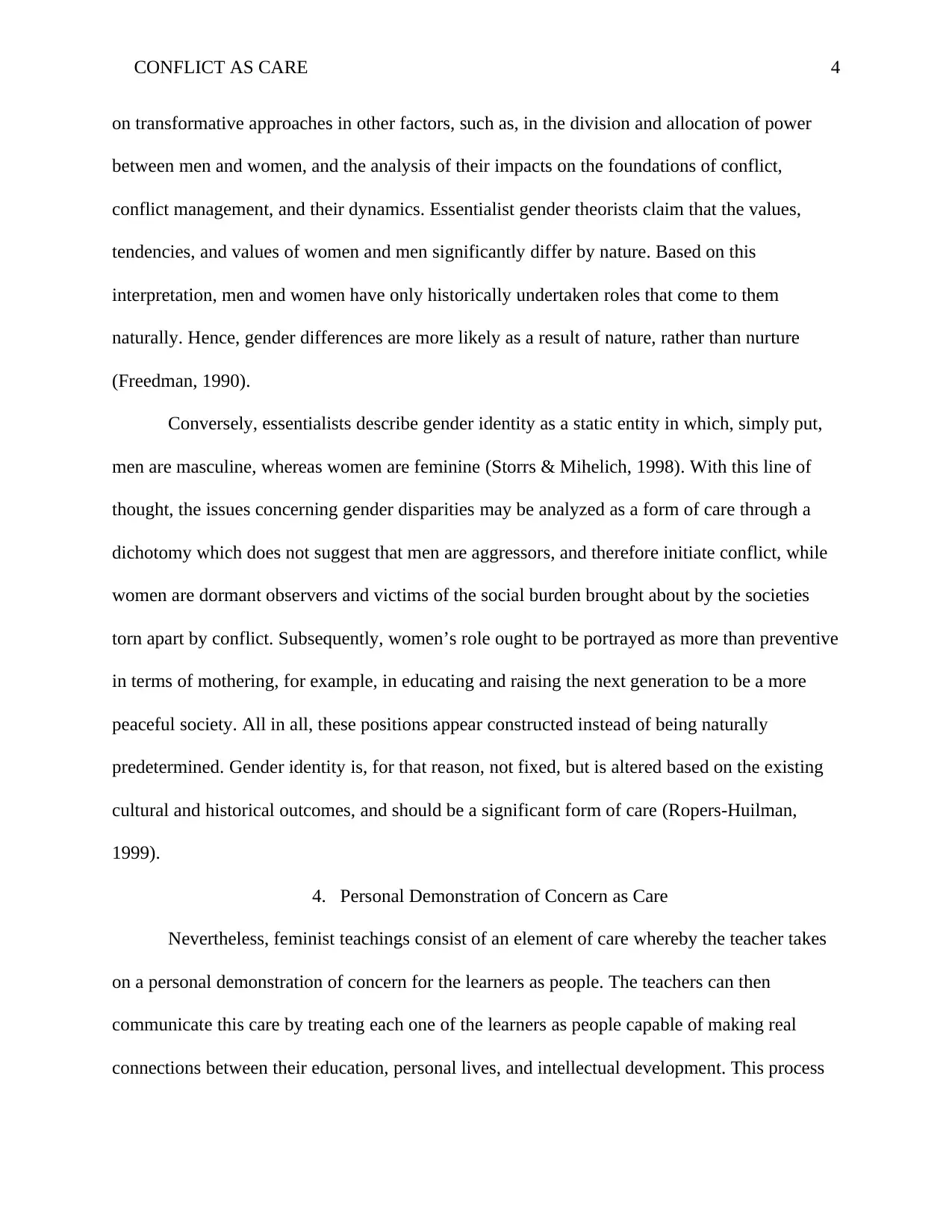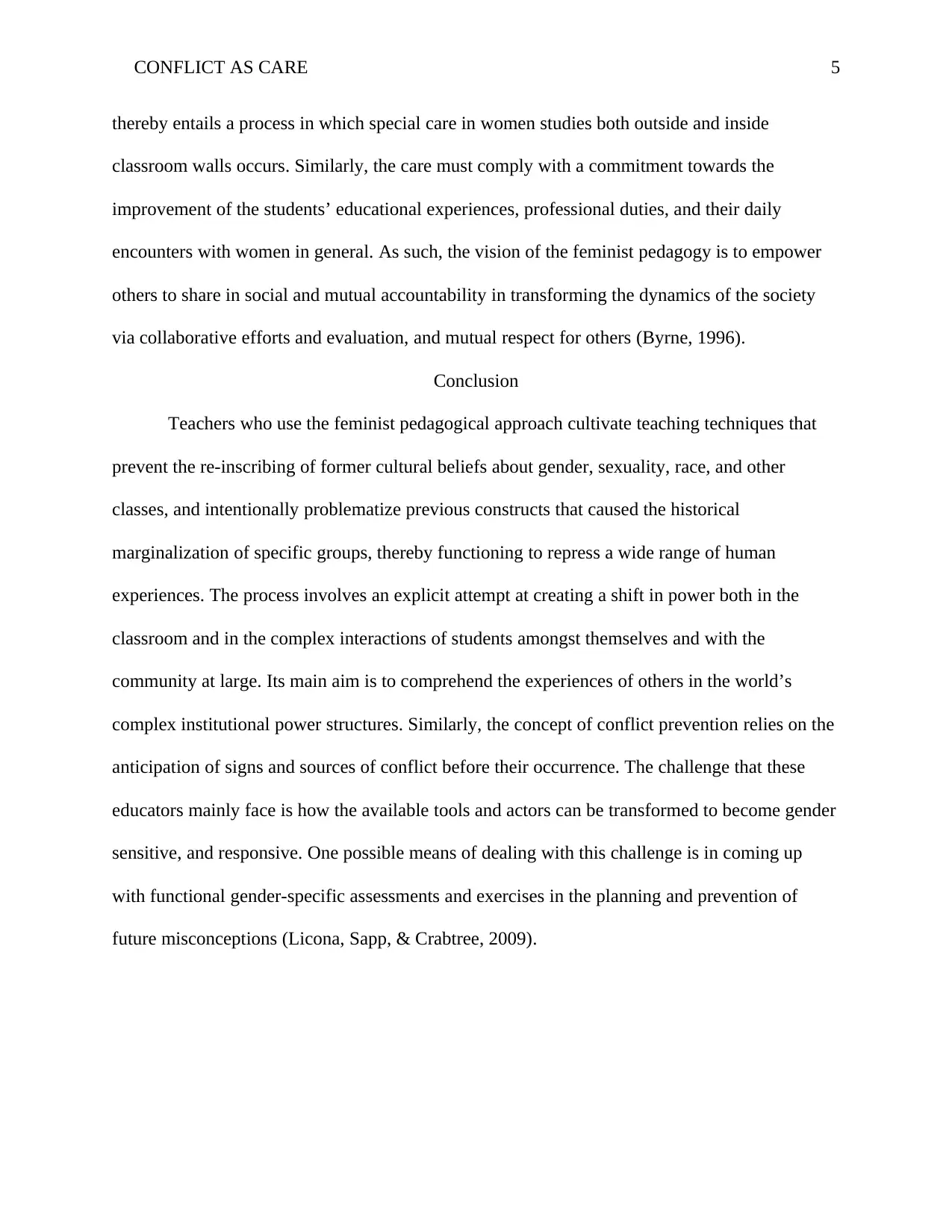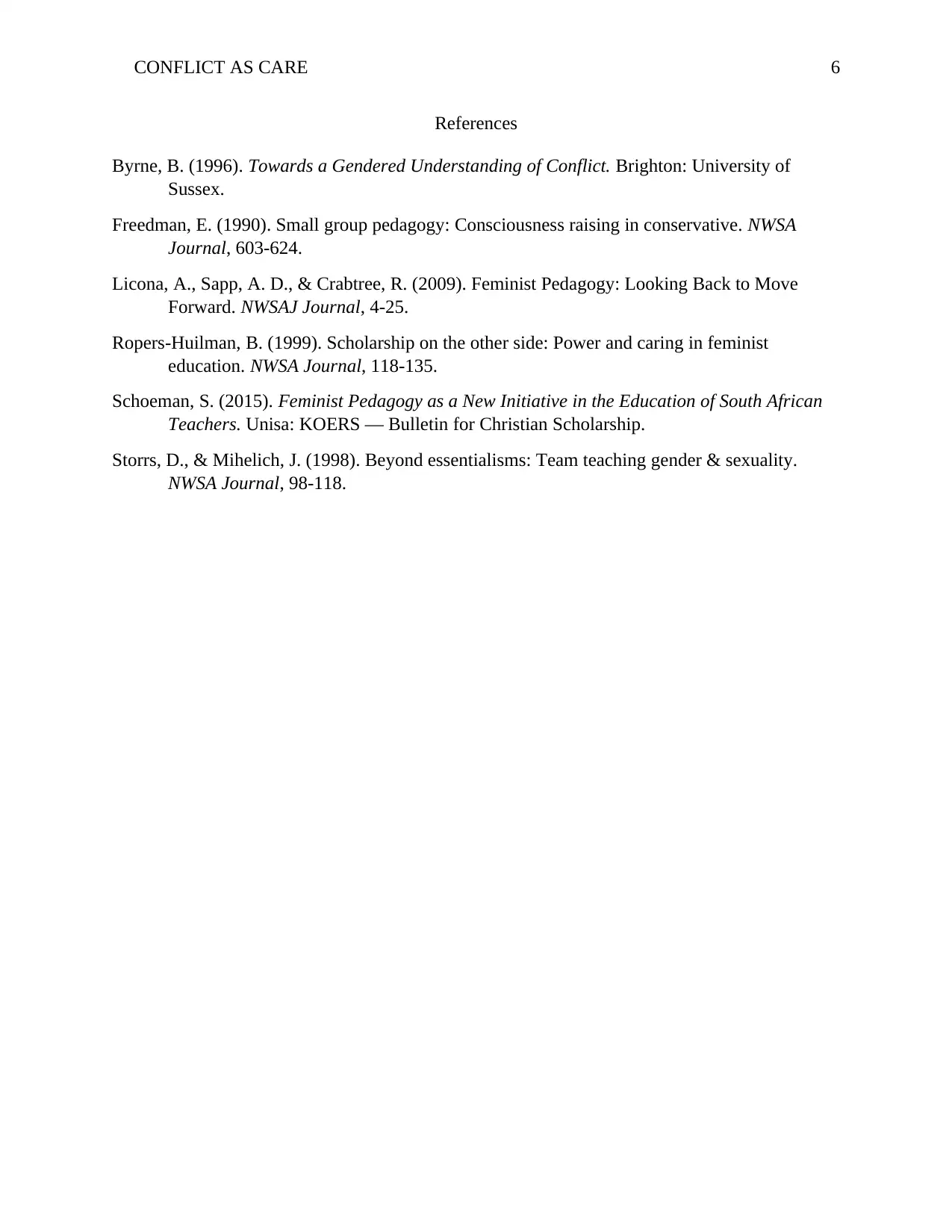Conflict as Care: Feminist Pedagogy and Its Impact on Education
VerifiedAdded on 2023/04/05
|6
|1266
|104
Essay
AI Summary
This paper delves into the concept of 'conflict as care' within the framework of feminist pedagogy. It begins by examining how feminist pedagogy fosters nurturing classroom environments, emphasizing care and interaction over traditional hierarchies. The essay then explores how feminist educators address issues of authority and struggle, viewing them as opportunities for critical thinking and empowerment. Furthermore, it analyzes gender disparity as a form of care, prompting reflection on societal roles and values. The paper also discusses personal demonstration of concern as a key element of feminist teaching, where teachers connect education to students' lives and intellectual development. The conclusion highlights the importance of feminist pedagogy in deconstructing cultural beliefs and power structures, ultimately aiming to transform societal dynamics through collaborative efforts and mutual respect. The paper references several key texts related to feminist pedagogy and conflict resolution.

Running head: CONFLICT AS CARE 1
Conflict as Care Paper
Student Name
Institution
Conflict as Care Paper
Student Name
Institution
Paraphrase This Document
Need a fresh take? Get an instant paraphrase of this document with our AI Paraphraser

CONFLICT AS CARE 2
Conflict as Care
Introduction
Currently, there is a rapidly changing practical and conceptual perception of conflict. In
more recent studies, conflict entails a variety of bases including human rights violations,
environmental deprivation, and poor governance. Consequently, these causes have instigated the
fact that conflict prevention, its management, and peacekeeping all require an urgent change in
the understanding of actors and other relevant instances of action. According to Licona, Sapp,
and Crabtree (2009), feminist pedagogy is teaching founded on much more than the philosophies
on women and other feminist perspectives. It is a teaching that involves the re-examination,
reimagining, and analysis of what takes place behind classroom doors with the purpose of
restructuring the relationship between students and teachers, with education and society.
Feminist pedagogy, therefore, results in conflict founded on the desire to re-invent though into
deeds by criticizing the manners in which both traditional scientific and academic analyses
ignored or invalidated the experience of the female population (Licona, Sapp, & Crabtree, 2009).
Therefore, the purpose of this paper is to analyze how feminist pedagogy takes on somewhat
subjective and conflict-centered ways of knowing as the ultimate tools of proper knowledge
production.
1. Nurturing Environment as Care
The dominant discrepancy in feminist teaching gathers theories on gender differences in
education with the hope of provoking thought in traditional forms of thought, and in revealing
the existence of free and masculine lines of thought. Feminist educators hence insist on thought
processes and revision as care as opposed to merely dwelling on male-centered deductions. By
so doing, they promote a somewhat adversarial style with a focus on personal and tentative
Conflict as Care
Introduction
Currently, there is a rapidly changing practical and conceptual perception of conflict. In
more recent studies, conflict entails a variety of bases including human rights violations,
environmental deprivation, and poor governance. Consequently, these causes have instigated the
fact that conflict prevention, its management, and peacekeeping all require an urgent change in
the understanding of actors and other relevant instances of action. According to Licona, Sapp,
and Crabtree (2009), feminist pedagogy is teaching founded on much more than the philosophies
on women and other feminist perspectives. It is a teaching that involves the re-examination,
reimagining, and analysis of what takes place behind classroom doors with the purpose of
restructuring the relationship between students and teachers, with education and society.
Feminist pedagogy, therefore, results in conflict founded on the desire to re-invent though into
deeds by criticizing the manners in which both traditional scientific and academic analyses
ignored or invalidated the experience of the female population (Licona, Sapp, & Crabtree, 2009).
Therefore, the purpose of this paper is to analyze how feminist pedagogy takes on somewhat
subjective and conflict-centered ways of knowing as the ultimate tools of proper knowledge
production.
1. Nurturing Environment as Care
The dominant discrepancy in feminist teaching gathers theories on gender differences in
education with the hope of provoking thought in traditional forms of thought, and in revealing
the existence of free and masculine lines of thought. Feminist educators hence insist on thought
processes and revision as care as opposed to merely dwelling on male-centered deductions. By
so doing, they promote a somewhat adversarial style with a focus on personal and tentative

CONFLICT AS CARE 3
ideologies. Also, feminist teachers rely on proper interaction and integration as a form of
educational care in place of male-inspired hierarchies and deductions. They thus become friendly
advisors and maternal mentors who provide loving attention in the way of encouragement and
care to their students’ thought processes. Byrne (1996) states that classrooms under feminist
figures become a safe and nurturing environment, hence caring, in which students can speak and
write freely while resolving conflicts and remaining connected.
2. Dwelling on Issues of Authority and Struggles as Care
In the modern world, the contributions of the visions behind feminist pedagogy remain
remarkably visible. However, there remains a problem ascribed to a perfect image whereby the
caring atmosphere is believed to have little to do with conflict and power in classroom settings.
Feminist instructors think that the removal of the signs of both struggle and authority will do
nothing to alter their influences as invested in them by the political and social aspects of the
education process. For instance, while a teacher may first set out as a nurturer, they will have to,
at some point, step back and give grades. Such contradictions to the vision may likely lead to
general distress instead of the intended empowerment (Ropers-Huilman, 1999). As such,
authority, and dwelling on issues of struggle and dominance as seen as a form of care which
prompts thought provocation among students.
3. Gender Disparity as a Form of Care
By taking feminist pedagogy as an analytical category, the issue of gender prompts
people to inquire whether both men and women, as carriers of social and political agents, really
have a distinctive set of values. In this case, how would this then affect their roles in the society,
including their needs, interests, and ability to actively participate in matters of political, social
and economic, and educational advancements? This form of care also influences people to take
ideologies. Also, feminist teachers rely on proper interaction and integration as a form of
educational care in place of male-inspired hierarchies and deductions. They thus become friendly
advisors and maternal mentors who provide loving attention in the way of encouragement and
care to their students’ thought processes. Byrne (1996) states that classrooms under feminist
figures become a safe and nurturing environment, hence caring, in which students can speak and
write freely while resolving conflicts and remaining connected.
2. Dwelling on Issues of Authority and Struggles as Care
In the modern world, the contributions of the visions behind feminist pedagogy remain
remarkably visible. However, there remains a problem ascribed to a perfect image whereby the
caring atmosphere is believed to have little to do with conflict and power in classroom settings.
Feminist instructors think that the removal of the signs of both struggle and authority will do
nothing to alter their influences as invested in them by the political and social aspects of the
education process. For instance, while a teacher may first set out as a nurturer, they will have to,
at some point, step back and give grades. Such contradictions to the vision may likely lead to
general distress instead of the intended empowerment (Ropers-Huilman, 1999). As such,
authority, and dwelling on issues of struggle and dominance as seen as a form of care which
prompts thought provocation among students.
3. Gender Disparity as a Form of Care
By taking feminist pedagogy as an analytical category, the issue of gender prompts
people to inquire whether both men and women, as carriers of social and political agents, really
have a distinctive set of values. In this case, how would this then affect their roles in the society,
including their needs, interests, and ability to actively participate in matters of political, social
and economic, and educational advancements? This form of care also influences people to take
⊘ This is a preview!⊘
Do you want full access?
Subscribe today to unlock all pages.

Trusted by 1+ million students worldwide

CONFLICT AS CARE 4
on transformative approaches in other factors, such as, in the division and allocation of power
between men and women, and the analysis of their impacts on the foundations of conflict,
conflict management, and their dynamics. Essentialist gender theorists claim that the values,
tendencies, and values of women and men significantly differ by nature. Based on this
interpretation, men and women have only historically undertaken roles that come to them
naturally. Hence, gender differences are more likely as a result of nature, rather than nurture
(Freedman, 1990).
Conversely, essentialists describe gender identity as a static entity in which, simply put,
men are masculine, whereas women are feminine (Storrs & Mihelich, 1998). With this line of
thought, the issues concerning gender disparities may be analyzed as a form of care through a
dichotomy which does not suggest that men are aggressors, and therefore initiate conflict, while
women are dormant observers and victims of the social burden brought about by the societies
torn apart by conflict. Subsequently, women’s role ought to be portrayed as more than preventive
in terms of mothering, for example, in educating and raising the next generation to be a more
peaceful society. All in all, these positions appear constructed instead of being naturally
predetermined. Gender identity is, for that reason, not fixed, but is altered based on the existing
cultural and historical outcomes, and should be a significant form of care (Ropers-Huilman,
1999).
4. Personal Demonstration of Concern as Care
Nevertheless, feminist teachings consist of an element of care whereby the teacher takes
on a personal demonstration of concern for the learners as people. The teachers can then
communicate this care by treating each one of the learners as people capable of making real
connections between their education, personal lives, and intellectual development. This process
on transformative approaches in other factors, such as, in the division and allocation of power
between men and women, and the analysis of their impacts on the foundations of conflict,
conflict management, and their dynamics. Essentialist gender theorists claim that the values,
tendencies, and values of women and men significantly differ by nature. Based on this
interpretation, men and women have only historically undertaken roles that come to them
naturally. Hence, gender differences are more likely as a result of nature, rather than nurture
(Freedman, 1990).
Conversely, essentialists describe gender identity as a static entity in which, simply put,
men are masculine, whereas women are feminine (Storrs & Mihelich, 1998). With this line of
thought, the issues concerning gender disparities may be analyzed as a form of care through a
dichotomy which does not suggest that men are aggressors, and therefore initiate conflict, while
women are dormant observers and victims of the social burden brought about by the societies
torn apart by conflict. Subsequently, women’s role ought to be portrayed as more than preventive
in terms of mothering, for example, in educating and raising the next generation to be a more
peaceful society. All in all, these positions appear constructed instead of being naturally
predetermined. Gender identity is, for that reason, not fixed, but is altered based on the existing
cultural and historical outcomes, and should be a significant form of care (Ropers-Huilman,
1999).
4. Personal Demonstration of Concern as Care
Nevertheless, feminist teachings consist of an element of care whereby the teacher takes
on a personal demonstration of concern for the learners as people. The teachers can then
communicate this care by treating each one of the learners as people capable of making real
connections between their education, personal lives, and intellectual development. This process
Paraphrase This Document
Need a fresh take? Get an instant paraphrase of this document with our AI Paraphraser

CONFLICT AS CARE 5
thereby entails a process in which special care in women studies both outside and inside
classroom walls occurs. Similarly, the care must comply with a commitment towards the
improvement of the students’ educational experiences, professional duties, and their daily
encounters with women in general. As such, the vision of the feminist pedagogy is to empower
others to share in social and mutual accountability in transforming the dynamics of the society
via collaborative efforts and evaluation, and mutual respect for others (Byrne, 1996).
Conclusion
Teachers who use the feminist pedagogical approach cultivate teaching techniques that
prevent the re-inscribing of former cultural beliefs about gender, sexuality, race, and other
classes, and intentionally problematize previous constructs that caused the historical
marginalization of specific groups, thereby functioning to repress a wide range of human
experiences. The process involves an explicit attempt at creating a shift in power both in the
classroom and in the complex interactions of students amongst themselves and with the
community at large. Its main aim is to comprehend the experiences of others in the world’s
complex institutional power structures. Similarly, the concept of conflict prevention relies on the
anticipation of signs and sources of conflict before their occurrence. The challenge that these
educators mainly face is how the available tools and actors can be transformed to become gender
sensitive, and responsive. One possible means of dealing with this challenge is in coming up
with functional gender-specific assessments and exercises in the planning and prevention of
future misconceptions (Licona, Sapp, & Crabtree, 2009).
thereby entails a process in which special care in women studies both outside and inside
classroom walls occurs. Similarly, the care must comply with a commitment towards the
improvement of the students’ educational experiences, professional duties, and their daily
encounters with women in general. As such, the vision of the feminist pedagogy is to empower
others to share in social and mutual accountability in transforming the dynamics of the society
via collaborative efforts and evaluation, and mutual respect for others (Byrne, 1996).
Conclusion
Teachers who use the feminist pedagogical approach cultivate teaching techniques that
prevent the re-inscribing of former cultural beliefs about gender, sexuality, race, and other
classes, and intentionally problematize previous constructs that caused the historical
marginalization of specific groups, thereby functioning to repress a wide range of human
experiences. The process involves an explicit attempt at creating a shift in power both in the
classroom and in the complex interactions of students amongst themselves and with the
community at large. Its main aim is to comprehend the experiences of others in the world’s
complex institutional power structures. Similarly, the concept of conflict prevention relies on the
anticipation of signs and sources of conflict before their occurrence. The challenge that these
educators mainly face is how the available tools and actors can be transformed to become gender
sensitive, and responsive. One possible means of dealing with this challenge is in coming up
with functional gender-specific assessments and exercises in the planning and prevention of
future misconceptions (Licona, Sapp, & Crabtree, 2009).

CONFLICT AS CARE 6
References
Byrne, B. (1996). Towards a Gendered Understanding of Conflict. Brighton: University of
Sussex.
Freedman, E. (1990). Small group pedagogy: Consciousness raising in conservative. NWSA
Journal, 603-624.
Licona, A., Sapp, A. D., & Crabtree, R. (2009). Feminist Pedagogy: Looking Back to Move
Forward. NWSAJ Journal, 4-25.
Ropers-Huilman, B. (1999). Scholarship on the other side: Power and caring in feminist
education. NWSA Journal, 118-135.
Schoeman, S. (2015). Feminist Pedagogy as a New Initiative in the Education of South African
Teachers. Unisa: KOERS — Bulletin for Christian Scholarship.
Storrs, D., & Mihelich, J. (1998). Beyond essentialisms: Team teaching gender & sexuality.
NWSA Journal, 98-118.
References
Byrne, B. (1996). Towards a Gendered Understanding of Conflict. Brighton: University of
Sussex.
Freedman, E. (1990). Small group pedagogy: Consciousness raising in conservative. NWSA
Journal, 603-624.
Licona, A., Sapp, A. D., & Crabtree, R. (2009). Feminist Pedagogy: Looking Back to Move
Forward. NWSAJ Journal, 4-25.
Ropers-Huilman, B. (1999). Scholarship on the other side: Power and caring in feminist
education. NWSA Journal, 118-135.
Schoeman, S. (2015). Feminist Pedagogy as a New Initiative in the Education of South African
Teachers. Unisa: KOERS — Bulletin for Christian Scholarship.
Storrs, D., & Mihelich, J. (1998). Beyond essentialisms: Team teaching gender & sexuality.
NWSA Journal, 98-118.
⊘ This is a preview!⊘
Do you want full access?
Subscribe today to unlock all pages.

Trusted by 1+ million students worldwide
1 out of 6
Your All-in-One AI-Powered Toolkit for Academic Success.
+13062052269
info@desklib.com
Available 24*7 on WhatsApp / Email
![[object Object]](/_next/static/media/star-bottom.7253800d.svg)
Unlock your academic potential
Copyright © 2020–2025 A2Z Services. All Rights Reserved. Developed and managed by ZUCOL.